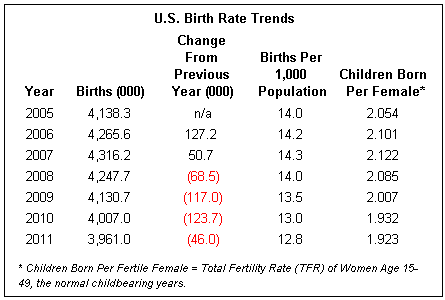IDEX Online Research: Slowing U.S. Birth Rate Affects Jewelry Demand
August 16, 12
(IDEX Online) – The number of births has declined modestly for the past four years in the American market, according to the latest data from the
Is this just a bit of trivia? Or is this important for jewelers? Jewelry demand in the
Why is jewelry demand sensitive to the number of children being born in the
· Jewelry is often given as a gift in honor of a newborn.
· Diamond engagement jewelry demand is especially sensitive to the birth rate; thus, demand for this all-important category will be weaker around 2035, when today’s babies will begin to get engaged to be married.
The number of births peaked in 2007, according to NCHS data, and has been slipping very modestly ever since, though the rate of decline moderated in 2011. The table below illustrates trends related to the number of births in the
 Source: NCHS |
Population Estimates Subject To Adjustment
Most population estimates call for at least 415 million people in the
However, all of the population estimates are being driven by a “total fertility rate” (TFR) of just over 2.1 children per woman, a rate that has been stable in the
As it turns out, the total fertility rate in the
Resilient Fertility?
Currently, most forecasters blame the recent Great Recession of 2007-2009 for the downturn in the number of births, as couples have put off having children until the economy stabilized.
For the birth rate to begin to rise, people need to feel that the economic recovery is real, and not likely to falter. Then, there is the inevitable nine-month delay related to the gestation period for humans. Some forecasters are already calling for an increase in the fertility rate, based on the smaller birth decline in 2011. However, there are some other challenges to the potential increase in the
More Intense Marketing
How should jewelers react to this latest challenge to jewelry demand? More intense marketing efforts will be needed. At the store level, more sales training will be needed to increase the conversion rate – browsers to buyers. Industry groups will need to focus on increasing demand for their particular products, similar to the efforts by De Beers to promote its Forevermark diamonds.
The concept of “if you build it, they will come” is under attack from many forces, and only the savvy jewelers will survive.